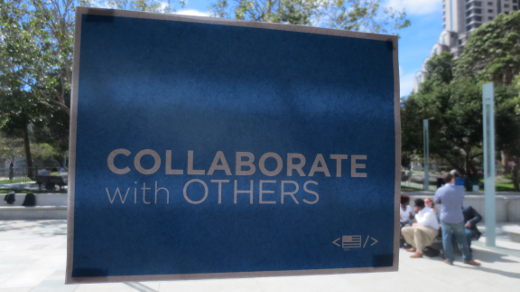Imagine I'm working on the front line of an open organization, and I'm committed to following principles like transparency, inclusivity, adaptability, collaboration, community, accountability, and commitment to guide that front-line work. A huge problem comes up. My fellow front-line workers and I can't handle it on our own, so we discuss the problem and decide that one of us has to take it to top management. I'm selected to do that.
When I do, I learn there is nothing we can do about the problem within the company. So management decides to let me present the issue to outside individuals who can help us.
In my search for the expertise required to fix the problem, I learned that no single individual has that expertise—and that we must find an outside, skilled partner (company) to help us address the issue.
All companies face this kind of problem and must form strategy business alliances from time to time. But it's especially common for open organizations, which Jim Whitehurst (in The Open Organization) specifically defines as organizations that "engage participative communities both inside and out." How, though, does this actually work?
Let's take a look at how transparency, inclusivity, adaptability, collaboration, community, accountability and commitment impact on two partner companies working together on a project.
Three stages of collaboration
Several years back, I formed an alliance between my company's operation in China and an American company. My company is Japanese, and establishing a working relationship between American, Japanese, and Chinese partners was challenging (I'll discuss this project more in detail later). Being successful meant I had to study various ways to form effective business alliances.
Basically, this is what I learned and put in practice in China. Developing strategic business alliances with a partner company involves three stages:
- Stage 1 is the "Discovery" stage.
- Stage 2 is the "Implementation" stage
- Stage 3 is the "Maintenance" stage
Here's what you can do in each stage to form lasting, effective and open alliances with external partners.
Discovery
In this stage, you want to decide on what you want to achieve with your proposed alliance. Simply put: What is your goal? The more detail with which you can express this goal (and its sub-goals), the higher your chance of success.
Next, you want to evaluate organizations that can support you to achieve those goals. What do you want them to do? What should you be responsible for (what don't you want them to do)? How do you want them to behave with you, especially regarding open organization principles? You should group each potential partner into three categories:
- Those following these principles now
- Those not following these principles now but who want to follow these principles and could with some support, explanation and training
- Those that do not have the desire or character to be more open in their behavior
After evaluating candidates, you should approach your ideal partner with a proposal for how you can work together on the specific project and reach an agreement.
This stage is the most important of the three. If you can get it right, the entire project will unfold in a timely and cost effective way. Quite often, companies do not spend enough time being open, inclusive, and collaborative to come to the best decision on what they want to achieve and what parameters are ideal for the project.
Implementation
In this stage, you'll start working with your alliance business partner on the project. Before you do that, you have to get to know your partner—and you have to get them to know you and your team. Your new partner may subscribe to open organization principles in general, but in practice those principles might not guide every member of the team. You'll therefore want to build a project team on both their side and yours, both of which adhere to the principles.
As I mentioned in a previous article, you will encounter people who will resist the project, and you'll need to screen them out. More importantly, you must find those individuals that will be very committed to the project and have the expertise to ensure success.
When starting a new project in any organization, you'll likely face at least three challenges:
- Competition with ongoing business for scarce resources
- Divided time, energy, and attention of shared staff
- Disharmony in the partnership and building a new community
Competition with ongoing business for scarce resources
If the needs of the new joint project grow, your project leader may have to prioritize your project over ongoing business (both yours and that of your partner's!). You both might have to request a higher budget. On the other hand, the ongoing business leaders might promote their own ongoing, core business to increase direct profits. So make a formal, documented allocation of funds for the project and an allocation of shared personnel's time. Confirm a balance between short-term (mostly ongoing related) and long-term (mostly the new joint project) gains. If the use of resources for a new joint project impacts (in any way) ongoing business, the new joint project budget should cover the losses. Leaders should discuss all contingency plans in advance of the concern. This is where transparency, adaptability, and collaboration become very important.
Divided time, energy and attention of shared staff
Your shared staff may consider the new joint project a distraction to their work. The shared staff from each company might be under short-term time pressure, for example. This is where front-line project commitment comes in. The shared staff might not consider the new joint project important. The shared staff might have stronger loyalties and formal ties to the ongoing business operation. The shared staff might feel the new joint project will damage the ongoing business operation (weaken brand and customer/supplier loyalties, cannibalize current business, etc.). In this case, you'll need to make sure that all stakeholders understand and believe in the value of the new joint project. This concept should be repeatedly promoted from the top level, mid-management level and operational level. All senior executives should be new joint project advocates when there is stress in time, energy, and attention. Furthermore, the new joint project leaders must be flexible and adaptable when the ongoing business becomes overloaded, as they are the profit-center of the organization that funds all projects. At the departmental level, the ongoing operation could charge the new joint project for excess work provided. A special bonus could be given to shared staff that work over a certain amount. This is where adaptability, collaboration, accountability, and commitment become very important.
Disharmony in partnership and building a new community
Differences are important for adding value to a project, but they could cause rivalry, too. One common source of conflict can be perceived skill level of individuals. Conflict could result if management heaps too much praise to one side (either ongoing business or the new joint project). Conflict could result from differing opinions on performance assessments. Conflict on compensation could occur. Conflict on decision authority could occur. To avoid these types of conflict, make the division of responsibility as clear as possible. Reinforce common values for both groups. Add more internal staff (less outside hires) on the project team to support cooperation, as they have established relationships. Locate key staff near the dedicated team for face-to-face interaction. This is where transparency, inclusivity, collaboration, community and commitment become exceedingly important.
Maintenance
After all the start-up concerns in the joint project have been addressed, and the project is showing signs of success, you should implement periodic evaluations. Is the team still behaving with a great deal of transparency, inclusivity, adaptability, collaboration, community, accountability, and commitment? Here again, consider three answers to these questions ("yes," "no," "developmental"). For "yes" groups, leave everything as-is. For "no" groups, consider major personnel and structural changes. For "developmental" groups, consider training, role playing, and possibly closer supervision.
The above is just an overview of bringing open organizations principles into strategic business alliance projects. Companies large and small need to form strategic alliances, so in the next part of this series I'll present some actual case studies for analysis and review.






Comments are closed.